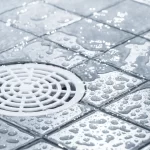How Does Water Freezing Cause a Burst Pipe?
Understanding why water freezing can cause a pipe to burst requires a grasp of both the physics of water and the nature of piping materials. This comprehensive exploration will break down the science behind frozen pipes, the steps to take when a pipe bursts, and strategies for preventing such issues in the future.
The Physics of Water Freezing
To comprehend why frozen water causes pipes to burst, it’s important to delve into the science of water freezing:
Water Molecules and Their Behavior:
- Liquid State: In liquid form, water molecules are in constant motion. They interact with each other but don’t form a fixed structure, which allows water to flow freely. This fluidity is why water can easily traverse through pipes and plumbing systems.
- Freezing Process: As the temperature drops and water approaches its freezing point (0°C or 32°F), the molecules begin to slow down. They start to arrange themselves into a more structured, crystalline form known as ice. This crystalline lattice is more orderly than the random arrangement of molecules in liquid water.
- Increased Volume: The crystalline structure of ice causes it to occupy more space than liquid water. In fact, water expands by approximately 9% when it freezes. This expansion occurs because the ice molecules are arranged in a way that takes up more room compared to their liquid counterparts.
Pressure from Ice Expansion:
- Pipe Constraints: Pipes are rigid and cannot expand to accommodate the increased volume of ice. As water freezes, it exerts significant pressure on the walls of the pipe. This pressure can be considerable, depending on the size of the pipe and the amount of water that freezes.
- Bursting Point: The pressure from expanding ice eventually exceeds the strength of the pipe material. This causes the pipe to crack or burst. The result is a sudden release of water, leading to potential flooding and significant damage to your home.
What to Do When a Pipe Bursts
If you experience a burst pipe, immediate action is crucial to minimize damage. Here’s a detailed guide on what to do:
- Stop the Water Flow
Locate the Shutoff Valve:
- Main Valve: The primary step is to stop the flow of water to prevent further flooding. Locate the main water shutoff valve for your home. This is typically found in the basement, crawl space, or near the water meter. Familiarize yourself with its location before an emergency occurs.
- Secondary Shutoffs: In some cases, you might be able to isolate the problem by turning off the water to the affected pipe or area. If this is not possible, shutting off the main valve is the best course of action.
Turn Off the Valve:
- Shut Off the Main Supply: Turn the main water supply valve clockwise to close it. This will stop all water flow into your home, reducing the risk of further damage.
- Emergency Shutoff: If the burst pipe is in an area with a separate shutoff valve, use it to control the specific section of the plumbing system.
Inform Household Members:
- Communication: Ensure all household members know where the shutoff valve is located and how to use it. This knowledge is essential in case of emergencies when you are not around.
- Repair the Burst Pipe
Call a Professional Plumber:
- Expert Help: Repairing a burst pipe is a complex task that requires expertise. Contact a licensed emergency plumber to handle the repair. Professional plumbers have the skills and tools necessary to address the issue effectively and safely.
- DIY Risks: Attempting to repair a burst pipe yourself can be risky. Incorrect repairs can lead to more significant problems and higher costs. It’s best to leave such tasks to professionals who can ensure a proper and lasting fix.
- Prevent Future Bursts
Insulate Your Pipes:
- Pipe Insulation: To prevent future occurrences of frozen pipes, consider insulating your pipes. Pipe insulation sleeves or wrap-around insulation materials can help maintain the temperature of the water inside the pipes, reducing the risk of freezing.
- Vulnerable Areas: Pay special attention to pipes in unheated areas such as basements, crawl spaces, and exterior walls.
Install Heating Measures:
- Heating Cables: For particularly cold areas, you may need to install heating cables or tape around vulnerable pipes. These devices provide additional warmth to prevent freezing.
- Heat Tape: Heat tape is another option that can be wrapped around pipes. It provides localized heat to keep the pipes from freezing.
Maintain Proper Heating:
- Consistent Temperature: Ensure that your home’s heating system is functioning properly and maintain a consistent temperature throughout the house. Keep the thermostat set to a temperature above freezing, even when you’re not at home.
- Heat in Key Areas: Make sure that areas with exposed or vulnerable pipes receive adequate heat. Open cabinet doors to allow warm air to circulate around pipes under sinks.
Monitor and Inspect:
- Regular Inspections: Regularly inspect your plumbing system for signs of wear or potential issues. Early detection of problems can help prevent them from escalating into emergencies.
- Professional Inspections: Consider scheduling periodic inspections with a licensed plumber. They can identify potential risks and make recommendations to prevent future issues.
Additional Tips for Burst Pipe Prevention:
Allow Faucets to Drip:
- Prevent Freezing: During extremely cold weather, allow faucets in vulnerable areas of your home to drip slightly. This keeps the water moving and reduces the chances of freezing.
- Prevent Ice Formation: Even a small, continuous drip can help prevent ice formation in pipes and reduce the risk of a burst.
Open Cabinet Doors:
- Circulate Warm Air: If pipes are located under sinks or in cabinets, open the cabinet doors to allow warmer air to circulate around the pipes. This helps keep the pipes above freezing temperatures.
Seal Gaps:
- Insulate Gaps: Seal any gaps or cracks around pipes, especially those located near exterior walls or in unheated areas. Use caulk or foam insulation to prevent cold air from reaching the pipes.
Conclusion
Frozen pipes can cause severe damage if they burst, leading to costly repairs and significant water damage. Understanding the science behind why water freezing leads to pipe bursts can help homeowners take proactive measures to prevent such issues. By stopping the water flow, repairing the burst pipe with professional help, and implementing preventive measures, you can protect your home from the adverse effects of frozen pipes. Regular maintenance, proper insulation, and vigilance are key to avoiding the inconveniences and expenses associated with burst pipes.






